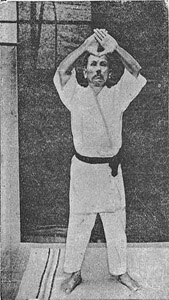 SHOTOKAN KARATE KATAS LIST
SHOTOKAN KARATE KATAS LIST
Heian Shodan – (peaceful mind, first level)
Heian Nidan – (peaceful mind, second level)
Heian Sandan – (peaceful mind, third level)
Heian Yondan – (peaceful mind, fourth level)
Heian Godan – (peaceful mind, fifth level)
Tekki
Initialement connu en Okinawa comme Naihanchi, les katas ont été renommés par Maître Funakoshi lorsqu'il est venu au Japon pour refléter la force exposée avec kiba-dachi. Riche en techniques de combat, les katas Tekki contiennent de techniques pour le combat rapproché.
Tekki Shodan – (iron horse riding, first level)
Tekki Nidan – (iron horse riding, second level)
Tekki Sandan – (iron horse riding, third level)
Advanced Katas
Bassai Dai (to penetrate a fortress – big) The strong techniques of this kata emphasize hip movement. Some resemble a battering ram being used against fortress walls.
Bassai Sho (to penetrate a fortress – small) This kata was derived from Bassai-Dai. It has a similar performance line.
Kanku Dai (to view the sky – big) Most of the elements of the Heian Kata were derived from this kata. The first movement in this kata views the sky, which symbolizes the universe and shows your opponent that you are unarmed. It was Master Funakoshi’s preferred kata.
Kanku Sho (to view the sky – small)
Kanku Sho was created from Kanku Dai. The movements and performance line are similar.
Hangetsu (half moon) This kata received its name from its principal stance, hangetsu dachi (half moon stance).
GojuShiHo Dai (fifty four steps – big) This kata is one of the most advance kata of Shotokan. Master Funakoshi called it hotaku (knocking of a woodpecker) because some of the techniques resemble a woodpecker tapping its beak against a tree.
GojuShiHo Sho (fifty four steps – small) This is a smaller version of Goju Shi Ho Dai. It is also one of the most advanced kata of Shotokan.
Empi (flying swallow) The quick up and down movements of this kata are reminiscent of a fling swallow. Enpi is one of the oldest kata in Shotokan. Its former name was Wanshu.
Jion (love and goodness) Jion is a term in Buddhism. It is also the name of a temple in China. It uses basic stances and techniques. It is one of the most traditional kata in Shotokan.
Jiin (love and shadow)Jiin is another term in Buddhism. It has similar techniques and performance line as Jion.
Jitte (ten hands) The goal of this kata is to teach a student to fight against ten opponents. This is a strong kata, similar to jion and Jiin..
Meikyo (bright mirror) The first movements of this kata suggest the smoothing of water to make it as calm and even as a mirror. The triangle jump at the end of this kata is said to have a secret meaning portending to a miracle.
Niju Shi Ho (twenty-four steps) The movements in this kata resemble waves breaking on a cliff. The former name of this kata was ni sei shi..
Wankan (king and crown) Is the shortest kata in Shotokan
Gankaku (crane on a rock) The main stance in this kata (tsuruashi dachi) resembles a crane ready to strike at its prey. The movements are supposed to simulate a fight in the narrow alleyways of Okinawa. The former name of this kata was Chinto.
Sochin (strength and calm) The name of this kata comes from its stance (sochin dachi), a strong, rooted stance. The purpose of this kata is to teach defense against a stick. Its former name was Hakko.
Chinte (rare hand) Chinte has a lot of circular and roundhouse techniques. These are rare and are not typical of the shortest distance between two points concept of Shotokan.
Unsu (cloud hands) Unsu has several techniques that symbolize parting the clouds with open hands. It is also one of the most advanced kata of Shotokan.
